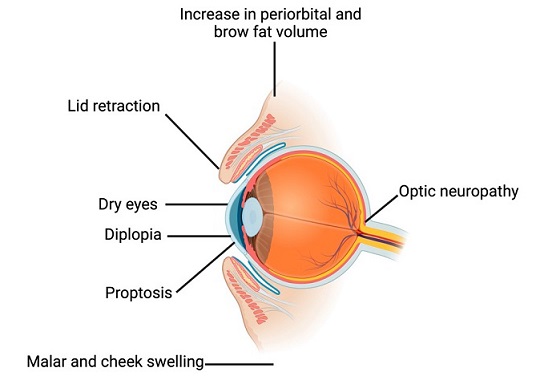Nikhil Prasad Fact checked by:Thailand Medical News Team Oct 31, 2024 11 months, 2 weeks, 1 day, 1 hour, 24 minutes ago
Medical News: Researchers from McGill University and the University of Montreal in Canada have published a comprehensive study offering new insights into Thyroid Eye Disease (TED), also known as Graves' orbitopathy. This condition, closely associated with thyroid disorders like Graves’ disease, leads to inflammation and swelling in the eye area, causing discomfort, double vision, and even vision loss in severe cases. The disease has a significant impact on the quality of life for affected individuals, often leading to emotional and financial challenges.
 Schematic representation of the clinical manifestations of thyroid eye disease. The most common clinical symptoms involved in thyroid eye disease are depicted in this illustration.
Schematic representation of the clinical manifestations of thyroid eye disease. The most common clinical symptoms involved in thyroid eye disease are depicted in this illustration.
This
Medical News report delves into the findings from the latest study, which highlights the complex immune processes underlying Thyroid Eye Disease and explores groundbreaking diagnostic and treatment approaches that could improve the lives of those affected.
Understanding the Causes of Thyroid Eye Disease
Thyroid Eye Disease primarily affects individuals with hyperthyroidism but can also develop in those with hypothyroidism or even without thyroid abnormalities. The study outlines how TED arises from the body’s immune system mistakenly attacking tissues around the eyes. Central to this process is the overactivation of specific cells, particularly orbital fibroblasts. These cells can transform into fat cells or scar-forming cells, which cause the characteristic eye bulging and tissue scarring seen in Thyroid Eye Disease.
The immune system plays a crucial role in TED's progression. Autoantibodies -specifically those targeting thyroid-stimulating hormone (TSH) and insulin-like growth factor-1 (IGF-1) - stimulate the activity of fibroblasts, causing them to grow and produce an inflammatory response. This leads to the tissue changes responsible for TED's symptoms, which range from eye pain and swelling to double vision and even severe complications like optic nerve damage.
Immune Dysregulation and Inflammation
As detailed in the study, Thyroid Eye Disease is characterized by immune system abnormalities that result in chronic inflammation and tissue remodeling in the eye orbit. The study shows that these processes are heavily influenced by cytokines, proteins that regulate immune responses and inflammation. Increased levels of certain cytokines, like IL-6 and TNF-alpha, amplify the disease’s severity by promoting inflammation and fibroblast activity.
The study also introduces newer insights on cellular proteins such as SOX9 and mechanosensitive receptors, which contribute to tissue changes in the eye. Through this immune activation, fibroblasts multiply, differentiate, and release substances like hyaluronan, which increase the eye’s fat and tissue volume. This tissue growth is what causes the eye-bulging symptom common in TED patients.
Diagnostic Innovations
Diagnosing T Thyroid Eye Disease early and accurately is essential
for preventing complications. Traditional methods like visual exams and eye movement tests are often supplemented with advanced imaging techniques such as CT and MRI scans. These scans provide a detailed view of eye tissue, enabling doctors to monitor disease progression and any risk to the optic nerve.
Moreover, the researchers are exploring liquid biopsy technology, a potential breakthrough that would allow doctors to analyze blood samples for TED biomarkers. Although still under development, liquid biopsy could provide a non-invasive and real-time monitoring tool, aiding early diagnosis and treatment decisions. This would especially benefit Thyroid Eye Disease patients by sparing them invasive tests and ensuring more timely interventions.
Advances in Treatment
Thyroid Eye Disease treatment typically involves a combination of anti-inflammatory drugs, immune-modulating therapies, and surgery for severe cases. However, recent advancements are introducing more targeted therapies aimed at the molecular causes of TED.
One of the most promising drugs is teprotumumab, an antibody that targets IGF-1 receptors. This drug has shown effectiveness in reducing eye bulging and inflammation by blocking the immune signals that drive fibroblast activity. Teprotumumab’s success is underscored by clinical trials showing it helps reduce proptosis (eye bulging) and overall disease activity in Thyroid Eye Disease patients. However, the drug is expensive and requires intravenous administration, limiting its availability for many patients.
In addition to teprotumumab, drugs like tocilizumab, which blocks the IL-6 receptor, and rituximab, which targets B-cells, offer promising second-line options for those who do not respond to standard treatments. These drugs help reduce inflammation by preventing specific immune responses that contribute to TED symptoms.
New drug candidates, including small-molecule inhibitors and other IGF-1R antagonists, are currently in clinical trials. If successful, these drugs may offer easier-to-administer and more affordable alternatives to existing therapies, making Thyroid Eye Disease treatment accessible to a broader patient population.
A Look Ahead: Future Therapies and Innovations
The study also explores emerging therapies that may reshape Thyroid Eye Disease management in the future. These include TSH receptor inhibitors, which directly target the underlying thyroid connection in Thyroid Eye Disease, and drugs that inhibit specific immune responses linked to fibroblast activation. As these treatments progress through clinical trials, they hold the potential to become essential tools in managing Thyroid Eye Disease, especially for patients who experience severe symptoms.
Conclusions
The findings underscore the complex interplay between immune system dysregulation and tissue changes in Thyroid Eye Disease. Understanding the role of autoantibodies, immune pathways, and cellular changes in Thyroid Eye Disease has led to the development of promising therapies that target the disease at its roots rather than merely addressing symptoms. Future innovations, including diagnostic liquid biopsy and more affordable, accessible treatment options, could offer new hope to those affected by Thyroid Eye Disease.
The study findings were published in the peer-reviewed International Journal of Molecular Sciences.
https://www.mdpi.com/1422-0067/25/21/11628
For the latest on Thyroid Eye Disease, keep on logging into Thailand
Medical News.
Read Also:
https://www.thailandmedical.news/news/new-insights-into-thyroid-dysfunction-triggered-by-covid-19-s-cytokine-storm
https://www.thailandmedical.news/news/viral-infections-including-covid-19-and-thyroid-cancer-a-new-threat-emerges
